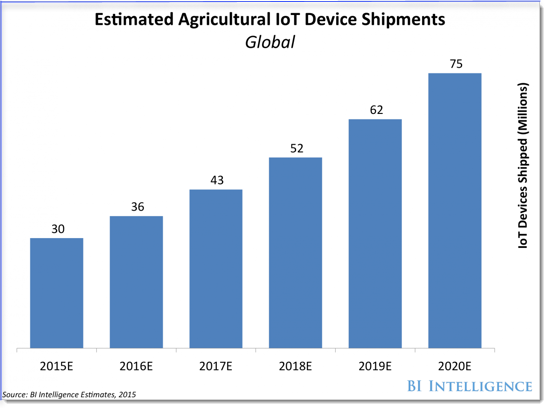
Cutting-edge technologies – from IoT connectivity to big data predictive analytics – are revolutionizing the agriculture market. Critical data about soil, water, weather, etc. is collected and transmitted by agricultural drones or sensors connected to gateways and IoT platforms. The analyzed data is then used to control machines, optimize irrigation and fertilization, track crop yields, monitor livestock, operate greenhouses, and so on.[1] As shown by the Business Insider chart to the right, the deployment of agricultural IoT devices is expected to double between 2016 and 2020.
What’s driving this growth?
In the developed world, the main driver for embracing smart agriculture is enhanced profitability. With more precise management of resources, farmers increase yield while reducing costs such as water, chemicals and labor. [2]
Taking a more global view, smart agriculture is critical to achieving food security for a growing population. As shown by the National Geographic chart below, agriculture already accounts for ~39% of the ice-free surface of the Earth that is being used by humans. With most of the undeveloped land not suitable for agriculture, we’re going to have to learn to produce more food per square mile. And that’s without considering the ever-growing challenges posed by climate change.

So just how big is the smart agriculture market going to get?
The smart agriculture market is expected to reach USD 18.45 billion by 2022, at a Compound Annual Growth Rate (CAGR) of 13.8% between 2016 and 2022, with the network element segment (gateways and IoT platforms) expected to experience the highest growth. [1] More specifically, the connected agriculture market is forecast to grow from USD 1.34 Billion in 2016 to USD 3.06 Billion by 2021, at a CAGR of 17.9%.
The major players in the smart agriculture market include equipment vendors such as AGCO; precision agriculture solution providers such as Raven Industries; GPS/drone companies such as Trimble Navigation; and biotech companies such as SemiosBIO Technologies, which develops non-toxic pest management products. The connected agriculture segment is dominated by major corporations such as Cisco, IBM and SAP.
The role of smart water management in agriculture
Agriculture is the single largest consumer of water in developed and undeveloped regions alike. It is not surprising, therefore, that the smart water management sector is expected to be the fastest growing segment within the connected agriculture market. [3]
Given the widely-accepted axiom that if you cannot measure something you cannot manage it, highly precise, IoT-ready ultrasonic water meters such as Arad’s Octave bulk meter have much to contribute to smart, sustainable management of water resources for agriculture. However, state-of-the-art ultrasonic water meters have not yet been embraced in the agricultural sector to the same extent that they have been adopted by municipal water utilities [4]. One can only assume that, with the rise of smart agriculture in general, high-precision measurement of agricultural water will become the norm.
References
[1] Smart Agriculture Market – Global Forecast to 2022, Markets and Markets, February 2016
[2] Smart Agriculture Market – Global Industry Analysis, Size, Share, Growth, Trends and Forecast 2016 – 2024, Transparency Market Research
[3] Connected Agriculture Market Worth 3.06 Billion USD by 2021, Markets and Markets, December 12, 2016
[4] Oliver Grievson et al, “Instrumentation, Control and Automation in the Global Water Industry”, Global Trends & Challenges in Water Science, Research and Management, International Water Association, September 2016